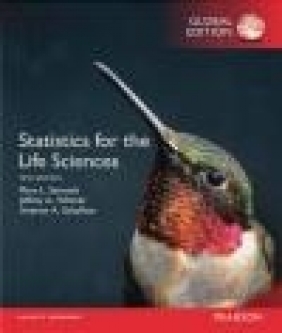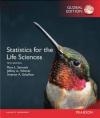Statistics for the Life Sciences
Andrew Schaffner, Jeffrey Witmer, Myra Samuels
Statistics for the Life Sciences
Andrew Schaffner, Jeffrey Witmer, Myra Samuels
- Producent: Pearson
- Rok produkcji: 2015
- ISBN: 9781292101811
- Ilość stron: 656
- Oprawa: Miękka
Niedostępna
Opis: Statistics for the Life Sciences - Andrew Schaffner, Jeffrey Witmer, Myra Samuels
For introductory undergraduate or graduate courses in statistics aimed at life science majors. Bringing Statistics to Life The Fifth Edition of Statistics for the Life Sciences uses authentic examples and exercises from a wide variety of life science domains to give statistical concepts personal relevance, enabling students to connect concepts with situations they will encounter outside the classroom. The emphasis on understanding ideas rather than memorizing formulas makes the text ideal for students studying a variety of scientific fields: animal science, agronomy, biology, forestry, health, medicine, nutrition, pharmacy, physical education, zoology and more. In the fifth edition, randomization tests have been moved to the fore to motivate the inference procedures introduced in the text. There are no prerequisites for the text except elementary algebra.UNIT I: DATA AND DISTRIBUTIONS 1. Introduction 1.1 Statistics and the Life Sciences 1.2 Types of Evidence 1.3 Random Sampling 2. Description of Samples and Populations 2.1 Introduction 2.2 Frequency Distributions 2.3 Descriptive Statistics: Measures of Center 2.4 Boxplots 2.5 Relationships Between Variables 2.6 Measures of Dispersion 2.7 Effect of Transformation of Variables 2.8 Statistical Inference 2.9 Perspective 3. Probability and the Binomial Distribution 3.1 Probability and the Life Sciences 3.2 Introduction to Probability 3.3 Probability Rules (Optional) 3.4 Density Curves 3.5 Random Variables 3.6 The Binomial Distribution 3.7 Fitting a Binomial Distribution to Data (Optional) 4. The Normal Distribution 4.1 Introduction 4.2 The Normal Curves 4.3 Areas under a Normal Curve 4.4 Assessing Normality 4.5 Perspective 5. Sampling Distributions 5.1 Basic Ideas 5.2 The Sample Mean 5.3 Illustration of the Central Limit Theorem 5.4 The Normal Approximation to the Binomial Distribution 5.5 Perspective Unit I Highlights and Study UNIT II: INFERENCE FOR MEANS 6. Confidence Intervals 6.1 Statistical Estimation 6.2 Standard Error of the Mean 6.3 Confidence Interval for mu 6.4 Planning a Study to Estimate mu 6.5 Conditions for Validity of Estimation Methods 6.6 Comparing Two Means 6.7 Confidence Interval for (mu1 - mu2) 6.8 Perspective and Summary 7. Comparison of Two Independent Samples 7.1 Hypothesis Testing: The Randomization Test 7.2 Hypothesis Testing: The t Test 7.3 Further Discussion of the t Test 7.4 Association and Causation 7.5 One-Tailed t Tests 7.6 More on Interpretation of Statistical Significance 7.7 Planning for Adequate Power 7.8 Student's t: Conditions and Summary 7.9 More on Principles of Testing Hypotheses 7.10 The Wilcoxon-Mann-Whitney Test 8. Comparison of Paired Samples 8.1 Introduction 8.2 The Paired-Sample t Test and Confidence Interval 8.3 The Paired Design 8.4 The Sign Test 8.5 The Wilcoxon Signed-Rank Test 8.6 Perspective Unit II Highlights and Study UNIT III: INFERENCE FOR CATEGORICAL DATA 9. Categorical Data: One-Sample Distributions 9.1 Dichotomous Observations 9.2 Confidence Interval for a Population Proportion 9.3 Other Confidence Levels (Optional) 9.4 Inference for Proportions: The Chi-Square Goodness-of-Fit Test 9.5 Perspective and Summary 10. Categorical Data: Relationships 10.1 Introduction 10.2 The Chi-Square Test for the 2 x 2 Contingency Table 10.3 Independence and Association in the 2 x 2 Contingency Table 10.4 Fisher's Exact Test 10.5 The r x k Contingency Table 10.6 Applicability of Methods 10.7 Confidence Interval for Difference Between Probabilities 10.8 Paired Data and 2 x 2 Tables 10.9 Relative Risk and the Odds Ratio 10.10 Summary of Chi-Square Test Unit III Highlights and Study UNIT IV: MODELING RELATIONSHIPS 11. Comparing the Means of Many Independent Samples 11.1 Introduction 11.2 The Basic One-Way Analysis of Variance 11.3 The Analysis of Variance Model 11.4 The Global F Test 11.5 Applicability of Methods 11.6 One-Way Randomized Blocks Design 11.7 Two-Way ANOVA 11.8 Linear Combinations of Means 11.9 Multiple Comparisons 11.10 Perspective 12. Linear Regression and Correlation 12.1 Introduction 12.2 The Correlation Coefficient 12.3 The Fitted Regression Line 12.4 Parametric Interpretation of Regression: The Linear Model 12.5 Statistical Inference Concerning beta1 12.6 Guidelines for Interpreting Regression and Correlation 12.7 Precision in Prediction 12.8 Perspective 12.9 Summary of Formulas Unit IV Highlights and Study 13. A Summary of Inference Methods 13.1 Introduction 13.2 Data Analysis Examples Chapter Appendices Chapter Notes Statistical Tables Answers to Selected Exercises
Producent:
GPSR Pearson Central Europe Sp. z o.o.
ul. Szamocka 8
01-748 Warszawa (PL)
tel: 459 596 060
email: [email protected]
Szczegóły: Statistics for the Life Sciences - Andrew Schaffner, Jeffrey Witmer, Myra Samuels
Tytuł: Statistics for the Life Sciences
Autor: Andrew Schaffner, Jeffrey Witmer, Myra Samuels
Producent: Pearson
ISBN: 9781292101811
Rok produkcji: 2015
Ilość stron: 656
Oprawa: Miękka
Waga: 1.1 kg






























